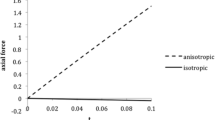Abstract
Finite extension and torsion tests on cardiac papillary muscles are presently the best way to directly measure the response to shear along myocardial fibers. Quantifying this response is necessary for determining the complete three-dimensional constitutive behavior of myocardium as a transversely isotropic material. Analysis of such tests is complicated, however, since papillary muscles are materially inhomogeneous, consisting of a myocardial core surrounded by an endocardial sheath that is rich in collagen. In this article, we show that the papillary muscle response to extension and torsion additively decouples into the response of the bare myocardial core plus the response of an endocardial sheath filled with fluid (assuming the muscle is a radially inhomogeneous and incompressible continuum with cylindrical symmetry). This result allows the endocardial response to be subtracted from the intact papillary muscle response to obtain the response of the bare myocardial core. An initial estimate suggests that the endocardial sheath affects the axial moment significantly (50% of torque for all twists at low stretch) but affects the axial force only slightly (<10% at moderate twists). © 1999 Biomedical Engineering Society.
PAC99: 8719Hh, 8719Rr, 8719Ff
Similar content being viewed by others
REFERENCES
Brutsaert, D. L., The endocardium. Annu. Rev. Physiol. 51:263–273, 1989.
Fung, Y. C. Biomechanics: Mechanical Properties of Living Tissues, 2nd ed. New York: Springer, 1993.
Humphrey, J. D. Computer methods in membrane biomechanics. Comp. Meth. Biomech. Biomed. Eng. (in press).
Humphrey, J. D., R. L. Barazotto, Jr., and W. C. Hunter. Finite extension and torsion of papillary muscles: A theoretical framework. J. Biomech. 25(5):541–547, 1992.
Humphrey, J. D., R. K. Strumpf, and F. C. P. Yin. Determination of a constitutive relation for passive myocardium. II. Parameter estimation. J. Biomech. Eng. 112:340–346, 1990.
Humphrey, J. D., R. K. Strumpf, and F. C. P. Yin. A constitutive theory for biomembranes: Application to epicardial mechanics. J. Biomech. Eng. 114:461–466, 1992.
Humphrey, J. D., and F. C. P. Yin. On constitutive relations and finite deformations of passive cardiac tissue: I. A pseudostrain-energy function. J. Biomech. Eng. 109:298–304, 1987.
Kang, T., J. D. Humphrey, and F. C. P. Yin. Comparison of biaxial mechanical properties of excised endocardium and epicardium. Am. J. Physiol. 270:H2169-H2176, 1996.
Lorang, D. M. Evaluation of Myocardial Mechanical Properties by Combined Extension and Torsion of Non-contracting Papillary Muscles. Baltimore: Johns Hopkins University Press, MSE Thesis, 1995.
MacKenna, D. A., J. H. Omens, A. D. McCulloch, and J. W. Covell. Contribution of collagen matrix to passive left ventricular mechanics in isolated rat hearts. Am. J. Physiol. 266:H1007-H1018, 1994.
Spencer, A. J. M. Continuum Mechanics. New York: Wiley, 1980, p. 160.
Yin, F. C. P., C. C. H. Chan, and R. M. Judd. Compressibility of perfused passive myocardium. Am. J. Physiol. 271:H1864-H1870, 1996.
Author information
Authors and Affiliations
Rights and permissions
About this article
Cite this article
Criscione, J.C., Lorenzen-Schmidt, I., Humphrey, J.D. et al. Mechanical Contribution of Endocardium During Finite Extension and Torsion Experiments on Papillary Muscles. Annals of Biomedical Engineering 27, 123–130 (1999). https://doi.org/10.1114/1.218
Issue Date:
DOI: https://doi.org/10.1114/1.218




